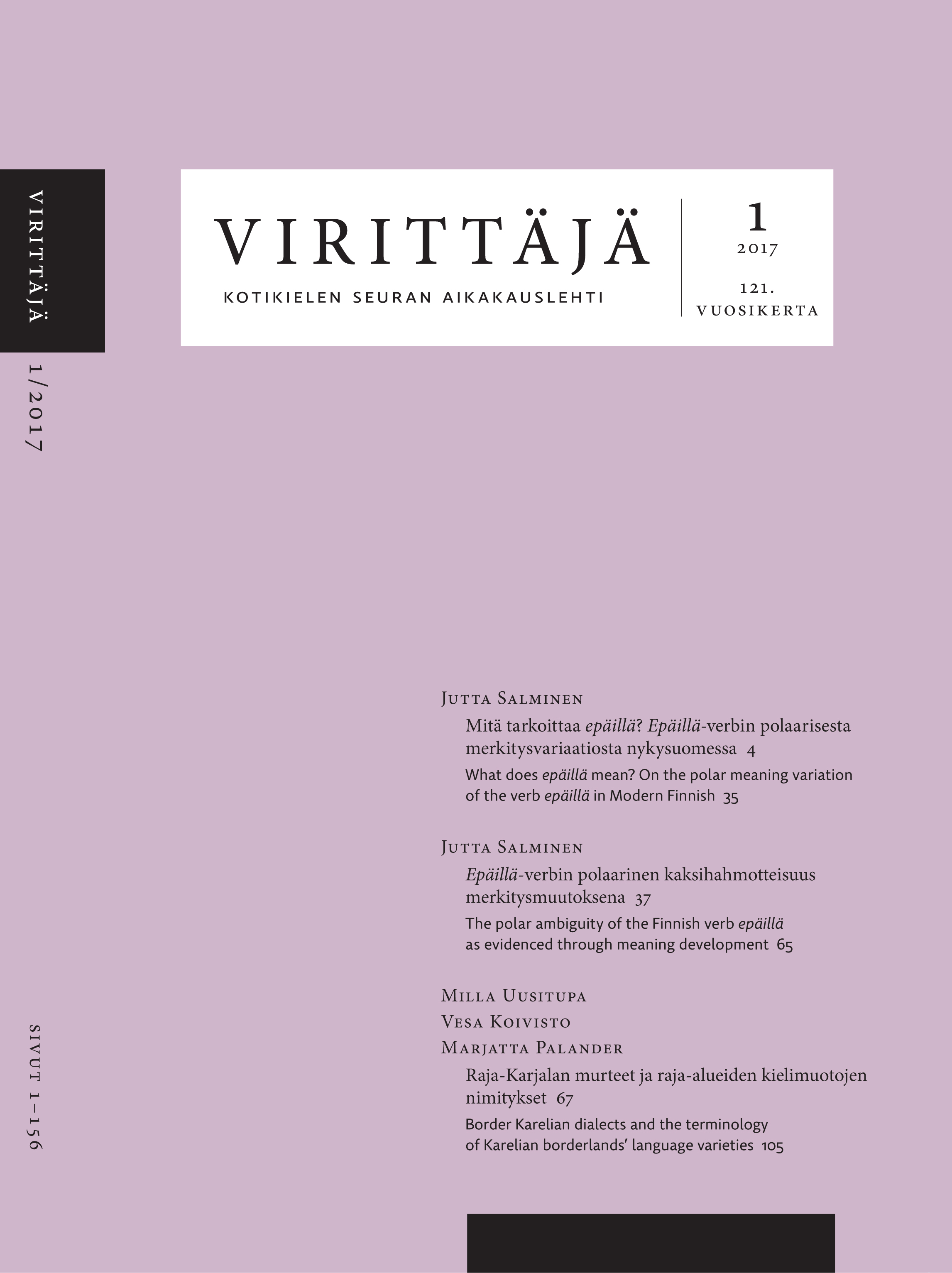Raja-Karjalan murteet ja raja-alueiden kielimuotojen nimitykset
Abstrakti
Artikkelissa tarkastellaan Raja-Karjalan aluetta kieli- ja murrekontaktien kenttänä. Tavoitteena on tuoda eri aikoina kerättyjen aineistojen ja aiemman tutkimuksen valossa esiin, miten variaation määrä, uskonnon ja kielen tiivis suhde sekä kahden eri kielen rinnakkaiselo erottavat Raja-Karjalan alueen suomen väli- ja sekamurrealueista. Artikkelissa pohditaan myös sitä, millä termillä rajakarjalaismurteita pitäisi kutsua. Variaation esittelyä ja terminologista pohdintaa taustoitetaan alueen historiaa valottavalla kirjallisuuskatsauksella.
Rajakarjalaismurteilla tarkoitetaan kielimuotoa, jota käytettiin Raja-Karjalassa – alueella, joka ennen vuosien 1939–1944 sotia kuului Suomeen. Karjalan eri murteiden ohella alueella kuuli savolaismurteita ja kaakkoismurteisiin kuuluvia Sortavalan seudun välimurteita. Artikkelin aineisto on Raja-Karjalan korpuksesta, joka sisältää 119 tuntia litteroituja murreäänitteitä Ilomantsista, Impilahdelta, Korpiselästä, Salmista, Suistamolta ja Suojärveltä. Lisäksi artikkelissa hyödynnetään 1800- ja 1900-lukujen vaihteessa muistiinmerkittyjä Raja-Karjalan kielioloja koskevia aikalaishavaintoja. Rajakarjalaisaineistoa tarkastellaan eri näkökulmista, sekä tuoreen variaation- ja murteentutkimuksen että historian- ja rajatutkimuksen valossa.
Raja-Karjalan erisuuntaiset ja -asteiset murre- ja kielirajat selittyvät alueen asutushistorialla. 1600-luvulla alue siirtyi Venäjältä Ruotsille, jolloin suuri osa sen väestöstä pakeni uusia hallitsijoita itään. Alue sai uusia asukkaita lännestä ja etelästä. Poismuuttajat olivat karjalankielisiä ortodokseja ja uudet asukkaat lähinnä luterilaisia savolaismurteiden puhujia. Raja-Karjalassa uskontoryhmät elivät rinnan, ja ajan kuluessa alue muokkautui ympäristöstään erottuvaksi kielialueeksi, jonka puhekieltä leimasi runsas yksilö- ja tilannekohtainen variaatio. Uskonnon merkitys kieltä määrittävänä tekijänä säilyi 1900-luvulle saakka.
Varhaisimmat merkinnät Raja-Karjalan kielioloista ovat 1800-luvun alusta, mutta murrealueen systemaattinen tutkimus on käynnistynyt vasta 2000-luvulla. Rajakarjalaismurteet kertovat suomen ja karjalan välisten kielikontaktien lisäksi myös raja-alueen omalaatuisesta historiasta, kulttuurista ja identiteetistä. Artikkelissa ehdotetaankin, että rajakarjalaismurteiden – ja muiden niihin vertautuvien raja-alueilla puhuttavien kielimuotojen – runsas yksilöllinen, kylittäinen ja tilanteittainen variaatio huomioitaisiin myös terminologiassa: rajakarjalaismurteita voitaisiin kutsua rajamurteiksi.
Border Karelian dialects and the terminology of Karelian borderlands’ language varieties
This article explores ’Border Karelia’ as a field of multiple and multifaceted dialect and language contacts. Border Karelia is a historical term that refers to the districts of Impilahti, Suistamo, Soanlahti, Salmi, Suojärvi, and Korpiselkä. Employing case studies and examples, the article illustrates the great variation that exists in the language varieties of this area. The results demonstrate how Border Karelia is distinctive from Finnish mixed, transitional and inter-dialects due to its high dialectal variation.
Prior to 1944, most Karelian-speaking Finns lived in Border Karelia. Moreover, the Finnish Savo dialects and the south-eastern transitional dialects of the Sortavala region were also spoken in this area. Thus, the coexistence of these closely-related languages and their dialects were the historical result of that region. Until the beginning of the 17th century, Border Karelia was part of Russia. The population of the area was mainly Karelian-speaking and belonged to the Orthodox Church. In 1617, however, Border Karelia became part of Sweden, and most of the Orthodox population fled eastwards. Border Karelia then experienced an influx of new inhabitants from the west and south, who were mainly Savo-speaking Lutherans. This 17th century migration had a significant impact on the linguistic landscape of the region, and over the following centuries, Border Karelia gradually morphed into an area linguistically distinct from other Karelian-speaking regions in Finland and Russia.
This article’s data is taken from the Corpus of Border Karelia, which contains some 119 hours of transcribed recordings from Ilomantsi, Impilahti, Korpiselkä, Salmi, Suistamo and Suojärvi. In addition, the article exploits contemporary notes and descriptions written in Border Karelia in the late 19th and early 20th centuries. The paper brings together the empirical and theoretical points of view concerning different aspects of linguistics – mainly variation study and dialectology – as well as social sciences, namely history and border studies.
Although the earliest linguistic findings from Border Karelia date from as far back as the early 19th century, there is a dearth of research into Border Karelian dialects. This article demonstrates and develops how dialects and languages are varyingly defined, and how borders are perceived differently from the perspectives of the internal experiencer vs external observer. Border Karelian dialects reveal much about not only the contact between Finnish and Karelian, but also the history, culture and identity of this borderland and its inhabitants. The paper introduces the term border dialect as a concept, to refer to language varieties spoken in different borderlands in different geographical locations, characterised by the extremely rich variation from one speaker to another, from one village to another, and from one social interaction to another.






